
|   |

|   |
An evening of Nritya Katha - Maya Kulkarni e-mail: chaddam@wpunj.edu October 11, 2014 On August 24, Rajika Puri and Ramya Ramnarayan came together to present an evening of story telling at Princeton Crossroads Theater in New Brunswick, New Jersey. 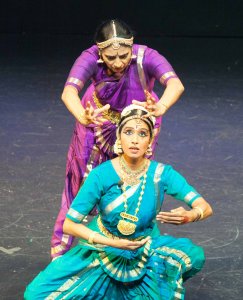 Rajika puts elephant head on Ganesha’s body From the opening dance ‘Ganesha’, the audience was made aware that they were to see something new, a merging of two separate dance idioms to bring to life stories and characters that populate Hindu mythologies. The praise offered to Ganesha, who is traditionally worshipped at the beginning of all events, went beyond the usual description of his attributes. In a brief collage of mudras and mime, both Ramya and Rajika told the story of his wondrously strange birth, death and resurrection. In the second dance ‘Savitri’, Rajika Puri narrated the story of a determined and devoted wife fighting for the life of her husband with the deity of death, Yama. The story is full of drama, highlighted by the metaphorical clash between love and death, characterized separately by Rajika with the use of a mask but also with masculine movement representing Yama and the more lyrical body movements undoubtedly depicting the determined Savitri. Rajika Puri uses voice, facial expression (abhinaya), mudras (hand gestures) in a seamless blend reinventing in our time the classic ‘Sutradhari’ tradition, where the narrator is at times outside and at other times part of the story. Sutradhari is a powerful idiom that combines the clarity of prose with the poetry of dance and mudras. Rajika has honed it to near perfection by drawing deeply on the inner conflicts of characters she portrays. 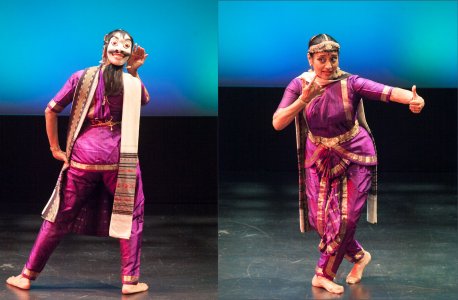 Rajika as Yama and as Savitri In ‘Natesha’, Ramya Ramnarayan depicted Siva, the iconic deity of cosmic dance who contains within his divine self, the natural opposites: the fury of fire in his aura and shining serenity of moon on his forehead, the destructive power of the trident in one hand and the blessing bestowed by another hand, the turbulence of the Ganges falling from his matted locks and the torpor of sleeping serpents resting on his body. Ramya’s Natesha personified each attribute beautifully. She concluded the dance with Navarasa, exploration of the nine emotional states embodied in Siva. Ramya moved with authority and power from the emotion of sringara or love to wonder, fear and rage, valor and disgust, ending in the infinite serenity of shanta, where all emotions finally dissolve. Her depiction of karuna or compassion was particularly beautiful. With superb control, she danced the story of Markandeya, a child devotee saved from certain death by god Siva himself. I have rarely seen such a beautiful unfolding of Siva in all his attributes. Her next solo ‘Yashoda Nandana’ set to a well-known lyric made famous in the inimitable voice of Subbalakshmi blended mother's love for her child with adoration for the same child Krishna, as the divine in human form. These two meanings are difficult to combine in dance but Ramya presented them with artistry and imaginative skill. She showed great emotional dexterity in moving rapidly from the character of the mother amused by the antics of her child to an adoring devotee. The mundane and the sublime in the story line came together in a perfect balance. 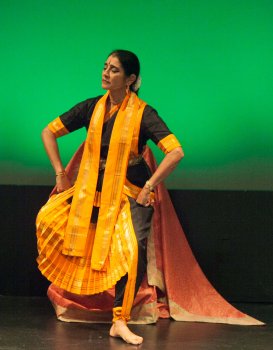 Rajika as Lord Rama on throne Rajika Puri’s last solo depicted king Rama in a reflective moment, reminiscing over the ironies of his life journey that compelled him to sacrifice love and comfort of family for kingly duty. As the story is told, Rama’s sad musings unfold: the first glimpse of his beloved wife, the love and attraction, abandonment of exile and war, followed by the triumphant return to his kingdom only to be diminished again by the call of kingly duty, the second and final parting with his beloved Sita. Rajika tells the story with infinite delicacy and superb control, one moment the Sutradhari and another, Rama himself, submerged in pain but aloof in observing his own loss. Rajika took Ramayana beyond the text to a deeper level where the audience and the dancer together discover the character of Rama haunted by a sense of failure. It was an imaginative and moving portrayal of Rama, the king and husband. 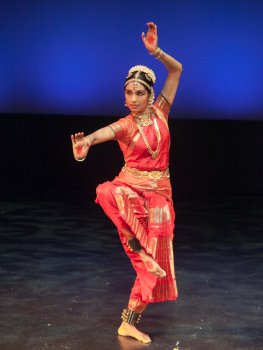 Ramya as Natesha The highlight of the evening was 'Kama,' the lord of desire who as the story unfolds, oversteps the limits of his power by targeting Siva while in meditation. Angry over being disturbed, Siva burns Kama to ashes. Love vanishes while beautiful bodied Kama becomes one without body, Ananga. This episode is full of ironies and drama. Rajika and Ramya blended their separate art forms into a seamless whole, alternating between the roles of Siva, Parvati, his hopeful consort, and Kama the mischievous demigod who is punished for his hubris. The lightening mood shifts, from romance to mischief, rage to fear and then to tragedy were riveting. Rajika Puri is a master performer who has drawn creatively from a variety of artistic dance and theater traditions to narrate stories in a novel form. Gifted with a resonant voice, she carries prose and poetry, speech and singing, embellished with mudras and body movements effortlessly. Her stories are deep studies of events and character. They transform the simple juxtaposition of good and bad into a study of existential dilemma. 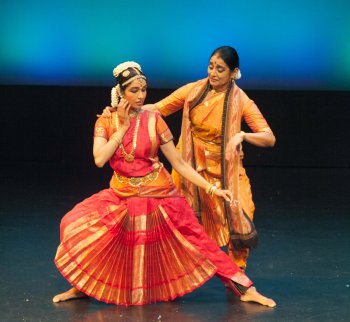 Ramya-Rajika as Parvati and Shiva flirting in Kama
Ramya Ramnarayan is a wonderful exponent of Bharatanatyam. Beautiful in form and face, gifted with a natural grace and clean body lines, she brings elegance and emotional depth to her dance narratives. Ramya delights with her perfect tala parmana and her expressive abhinaya. The detailed exploration of stories done to gripping mime makes her a pleasure to watch. Nritya Katha is an original concept bringing two very distinct narrative styles into a single program. For the audience, the parallel expositions of the Sutradhari tradition and Bharatanatyam uncover the extraordinary richness of India’s classical dance and theater forms. Maya Kulkarni performed extensively in the United States, Europe and India, and produced and choreographed several full-length dance dramas ('Shakuntala', 'Kumarasambhavam' etc.). Called "the dancer's dancer" by the NY Times, her ability to elicit rasa, through an understanding of text, music, and abhinaya is masterful. |